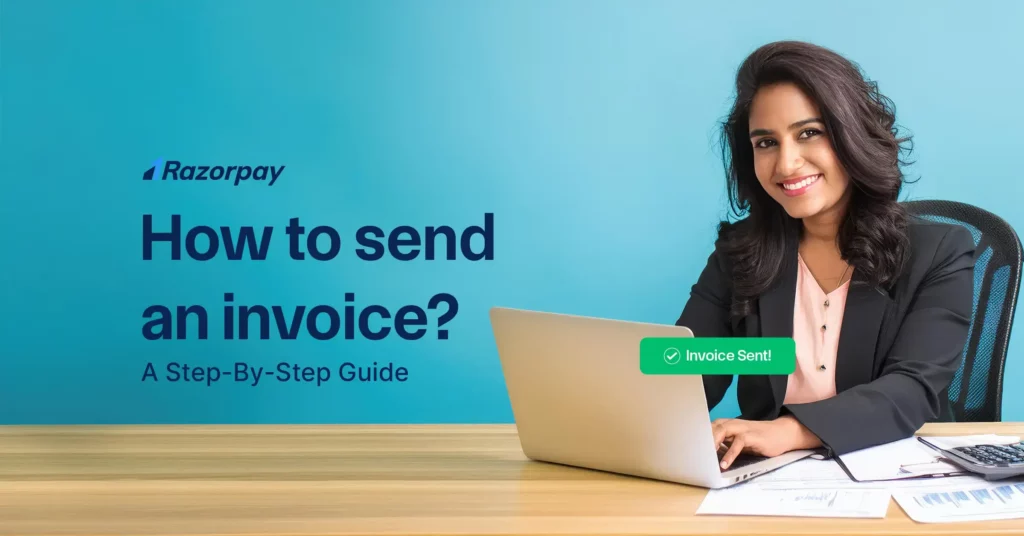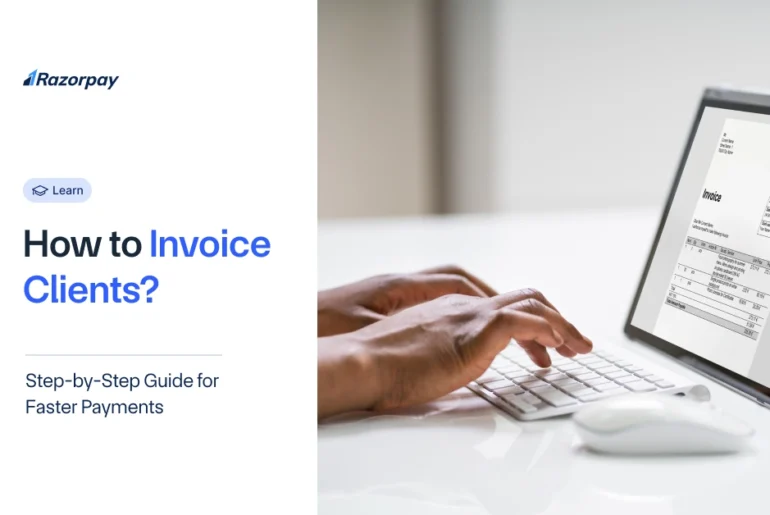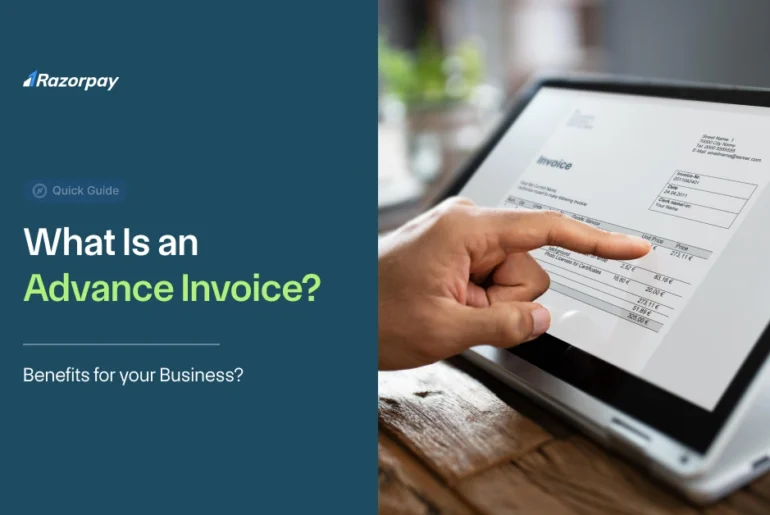In the business world, sending invoices promptly is important for maintaining cash flow and ensuring timely payments for your business. To process payments quickly and effectively, it’s important to learn how to send an invoice to client. These techniques for invoicing can help prevent delays and establish clear communication with clients.
Related Read: 15 Types of Invoices and Examples
Table of Contents
How to Send an Invoice Step-by-Step Process?
After completing a purchase, whether for a product or a service, it is important to quickly generate and send an invoice. Initially, you must consider whether you want to use invoicing software and how you want to send out your invoice.
Here’s a brief, step-by-step guide on how to create and submit a standard invoice:
- Label it “Invoice” at the top.
- Create a unique invoice number.
- Specify the date of the invoice.
- Include your business name, Address and contact information.
- Include your recipient’s name and address.
- Specify the date of delivery or service and a detailed description of the goods or services provided.
- State the amount due, including any taxes or fees, especially for GST invoices.
- Define the payment terms and due dates.
- Choose a method of invoice delivery to the client.
- Attach the invoice as a PDF and choose the delivery method.
- Track your invoice, set reminders, and get paid.
Related Read: What is Invoice Reconciliation and How to Reconcile Invoices?
What Are the Different Ways to Send an Invoice?
The best way to send invoices to clients depends on your business’s needs as well as the preferences of your clients. Each way has pros and cons of its own.
Here are a few ways you can send an invoice:
1. Online Invoicing
You can digitally produce an invoice using online invoicing solutions like Razorpay, and send it to customers via email or online portal. This method reduces delays and issues caused by paper billing.
Furthermore, many online invoicing platforms feature a “pay now” option, which allows customers to make rapid payments right from the invoice, significantly enhancing cash flow.
2. Invoicing Software
Using invoicing software provides various benefits, including customizable layouts, branding options, and convenient payment links.
Popular choices such as Razorpay simplify the invoicing processing, reduce the administrative effort of invoicing, eliminate errors and improve the billing process.
3. Email
Email is one of the easiest and fastest ways to submit an invoice. You can convert the invoice to a PDF before mailing it to ensure the formatting stays intact It’s important to include a clear subject line, like “Invoice #12345 from [Your Business Name],” and a summary in your email body.
This approach makes it simple to follow up and send reminders if the customer doesn’t respond or the invoice isn’t paid.
4. Physical Mail
Sending invoices by regular mail is a suitable choice for customers who don’t use email. In this case, you can print the invoice and send it through postal mail.
However, this method is slower and less secure than digital options, as invoices can be lost or intercepted, leading to potential disputes and delayed payments.
Create and send your invoices with Razorpay Invoicing Software
When Is the Best Time to Send an Invoice?
In order to reinforce the relationship between the transaction and the payment request, it is important to send an invoice to the client as soon as goods or services are delivered.
Furthermore, it’s crucial to review contracts for any specific payment terms, such as monthly services, to make sure your invoices match the agreed-upon timelines. Sending invoices sooner helps secure quicker payments and maintain cash flow.
Details to Include in an Invoice
A professional invoice usually contains important details such as:
- Business’s Information: The contact details of the service provider
- Customer’s Informations: The client or buyer’s information
- Invoice Number: A unique number assigned to the invoice for tracking, accounting, and documentation purposes.
- Description of Goods or Services: A detailed breakdown of the products or services provided.
- Unit Price: The cost of each individual item or the hourly rate for services.
- Quantity: The total number of items or hours of service delivered.
- The Total Amount Due: The total amount owed for the goods or services provided, as outlined in the agreed-upon terms and conditions.
- Invoice Date: The date of the invoice and service or good provided
- Clear terms for payment: Specify payment terms and accepted payment methods, including due dates.
- Applicable tax rates: The percentage of tax applied to the total amount due, as determined by local tax laws.
Using a custom invoice template is crucial for maintaining legal compliance and creating a professional image. Invoicing software that offers editable templates with all required information may streamline this process and improve billing efficiency and accuracy.
How to Clear the Invoice Faster?
1. Establish clear expectations upfront
Negotiate payment terms, including due dates and payment plans, to prevent misunderstandings and ensure timely payments.
2. Provide essential details
Include relevant project information, such as references or compliance details, to expedite approval and invoice payment processing.
3. Align with client processes
Reference purchase orders on your invoice to streamline client accounting and encourage prompt payment.
4. Offer flexible payment options
Provide various payment methods, including cash, checks, bank transfers, and credit cards, to accommodate customer preferences.
5. Accelerate payments
Utilize invoicing software with “Pay Now” options to enable fast online payments.
6. Implement automated reminders
Set up automatic reminders for overdue invoices to reduce manual effort and improve payment compliance.
Related Read: What is Overdue Payment?
7. Maintain open communication
Foster strong client relationships through regular communication, addressing inquiries promptly to ensure satisfaction and timely payments.
8. Incentivize early payment
Offer early payment discounts to encourage faster invoice settlement and improve cash flow.
Effective Ways to Follow Up After Sending an Invoice
Send Reminders: One way to encourage payment is to send a gentle reminder email a few days before the due date.
1. Automate Sending Unpaid Invoices
Automate the process with tools like Service Provider Pro (SPP). Customize your email templates and set reminder frequencies to efficiently manage overdue payments..
2. Initiate direct contact
Contact the client directly to address any concerns and discuss payment options.
3. Utilize convenient communication channels
Send a brief text or message through platforms like WhatsApp for quick and easy communication.
4. Schedule a meeting
Arrange a meeting for persistent overdue payments to discuss the situation and emphasize the importance of timely payment.
Related Read: How to Write a Professional Invoice Email
Common Mistakes One Should Avoid While Sending an Invoice
1. Delayed Invoice Submission
- Delays in sending invoices can lead to delayed payments, as clients may prioritize other obligations.
- While specific billing cycles might exist, such as monthly billing on the 1st or 15th, it’s generally best practice to invoice immediately upon completing work.
For example, freelance writers often invoice after submitting a draft, or even before starting a project if a partial advance is agreed upon.
2. Not Offering Multiple Payment Options:
- Limiting payment options can hinder your clients’ ability to pay, negatively impacting your cash flow.
- Offering diverse payment methods, such as bank transfers, credit/debit cards, direct deposits, and digital wallets, can significantly improve your chances of receiving timely payments.
3. Handling Unpaid Invoices
- Despite meticulous invoicing and clear payment terms, invoices can occasionally be overlooked or delayed.
- To address this, implement a system of gentle payment reminders. Following up with a courteous call can help verify invoice receipt and reaffirm payment arrangements.
4. Lack of Professionalism
- First impressions matter, and your invoice is often the final interaction with a client.
- A professional, customized invoice reflects your business’s professionalism and attention to detail.
- By incorporating your business logo and maintaining a clean, consistent design, you not only present a polished image but also create a valuable branding opportunity.
5. Lack of Digital Backup
- Protect your business with secure invoice backups. Unexpected system crashes can result in catastrophic data loss, including critical financial records like invoices.
- This not only hinders your ability to track customer payments but also poses significant challenges during audits or disputes.
- Safeguarding your invoices through cloud backups ensures easy accessibility and compliance with legal record-keeping requirements.e.
6. Unclear Payment Terms
- Clear and concise invoice payment terms are essential for smooth business operations.
- Avoid ambiguous language and industry jargon to prevent misunderstandings and disputes. Clearly outline payment methods, due dates, late fees, and refund policies.
- By providing comprehensive information and using simple language, you can streamline the payment process, reduce delays, and maintain positive client relationships.
- Remember, your invoice is a reflection of your professionalism, so present it clearly and accurately.
7. Adding Extra Fees
- Transparency is paramount in invoicing. Unexpected charges can damage client trust and relationships. Always communicate potential additional costs upfront.
- This proactive approach builds credibility and ensures clients are fully informed before receiving the invoice.
- Surprises on an invoice can lead to disputes and lost business, so maintain open communication throughout the project.
8. Wrong Invoicing
- Sending an invoice to the wrong recipient can have severe repercussions. Not only does it risk exposing sensitive client information, but it also damages your professional reputation and can lead to significant payment delays.
- To prevent this, always double-check and verify client contact information before sending invoices, especially when dealing with larger organizations with multiple departments. Remember, a simple oversight can have far-reaching consequences.
9. Incorrect or Missing Invoice Details
- Accuracy is paramount in invoicing. Errors in calculations, spelling, or missing information can lead to payment disputes and damage your business’s reputation.
- To ensure precision, include essential details like invoice number, tax identification numbers, payment due date, and total amount in the correct currency.
- Detailed itemization, clearly outlining goods or services, enhances clarity and prevents misunderstandings.
- A well-structured invoice reflects professionalism and builds trust with clients.
10. Use Digital Invoicing Software
- Streamline your invoicing process with digital invoicing software.
- Automate invoice creation, sending, and tracking.
- Reduce errors, save time, and improve cash flow.
- Access invoices anytime, anywhere, and boost your business efficiency.
Related Read: Quote vs Invoice: Key Differences Explained
Conclusion
Invoicing is essential for cash flow and customer satisfaction. Sending traditional paper invoices is becoming less relevant with the growth of e-invoicing, which streamlines processes and increases productivity. You can process a variety of invoice formats, including basic invoices, recurring invoices, and proforma invoices, making it flexible to a wide range of business needs.
Related Read: What is Invoice Trading?
Frequently Asked Questions
1. Can I send an invoice via email?
Yes, you can send an invoice via email. It’s a rapid and effective method of sending your invoice to your customer.
2. What is the best format for an invoice (PDF, Word, etc.)?
PDF is the best format for invoicing since it maintains formatting and is primarily accepted. Avoid using Word documents, which might cause formatting and compatibility issues.
3. How can I track if an invoice has been received and viewed?
You can use invoicing software with tracking tools, or request a read receipt via email.
4. Are there any legal requirements for sending an invoice?
Yes, invoices must include certain details, such as customer name, business name, date, amount owed, place of delivery, the GST registration number (if applicable) and an accurate itemization of services/products in India.
5. How do I handle late payments or unpaid invoices?
Send a payment reminder, followed by a formal notification if required. If payments are still late, consider negotiating a payment plan or getting professional collection assistance.
6. Can I automate the invoicing process?
Yes, you can use software to automate invoicing, including bills, payment reminders, and changes. This simplifies the procedure, reduces errors, and saves time.
7. How do I send a recurring invoice?
To issue a recurring invoice, create a billing schedule in your invoicing software, specifying the duration and amount. The software will produce and deliver the invoice automatically at regular intervals.
8. What should I do if a client disputes an invoice?
You must analyse the invoice information and collect supporting documents. Communicate with the customer as soon as possible to settle any issues and reach an agreement.
9. How do I send an international invoice?
For sending an international invoice, use professional invoicing software that accepts multiple currencies and foreign formats. Ensure compliance with both Indian and foreign tax legislation, and include all relevant information such as currency, payment conditions, and bank information.
10. What payment methods should I include in an invoice?
You should provide alternatives for bank transfers, credit cards, PayPal, and any local payment methods which your clients prefer, such as GooglePay, PhonePay, etc.
11. How do I follow up on an unpaid invoice?
Please send a polite email or message mentioning the outstanding invoice and its details.
12. Should I use invoicing software?
Yes, invoicing software streamlines the billing process, reduces mistakes, and improves professionalism.



